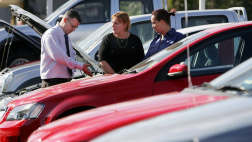Top of the list is its new "one size fits all" philosophy as Mazda reveals it will next year make a single vehicle platform to suit different models.
At its first showing in Berlin, Mazda previews its new diesel and petrol engines, new automatic and manual transmissions, and a raft of new chassis systems.
Though shown within old Mazda6 bodies, the drivetrains will be seen - as early as next year in Australia - in the upcoming Mazda3, Mazda6, new SUV models including the future CX-5, commercial vehicles and further out, in the small B-class car bracket in which Mazda2 sits.
Mazda also reveals it has achieved fuel consumption as low as 5.8litres/100km from a normally-aspirated 2-litre petrol four and 4.2-litres/100km from its new 2.2-litre bi-turbo diesel. More importantly, the engines meet future strict emission regulations including Euro-6. So here's what's new.
ENGINES
Mazda rolls out its Sky-G (gasoline) and Sky-D (diesel) engine range. Technically, they represent a fresh wave of ICE development. For example, a diesel usually has a very high compression ratio of about 20:1 but Sky-D has an unusually low 14:1.
The Sky-G also has 14:1 when normally-aspirated petrol engines are about 10:1. Powertrain Development Division head Mitsuo Hitomi says by raising the compression ratio and controlling cylinder head temperatures, it is possible to reduce fuel use. A side benefit - aided by a high-performance four-into-two-into-one exhaust system and long-stroke cylinder design - is a 15 per cent increase in torque while the longer stroker/smaller bore allows the cylinders to be placed closer and the engine block to be 20mm shorter and lighter.
Sky-G is a 2-litre engine but Mazda is finalising a 1.3-litre version that is intended for the Mazda2. A smaller diesel is also being developed. Both diesel and petrol engines - and manual and automatic transmssions - come with Mazda's "i-stop" stop-start system.
TRANSMISSIONS
There are four transmissions branded Sky-Drive: six-speed manuals and six-speed automatics for petrol and diesel applications. The big story is the lock-up system for all cars that Mazda claims allows up to 7 per cent fuel savings while delivering rapid shifts. Mazda is considering paddle shifters in some automatic models and even a "sports" shift button to accentuate shift points.
CHASSIS
Mazda shows the next Mazda6 body and chassis details and says it will be used across the board - with the same suspension design, steering and brakes. So Mazda3 would use identical Mazda6 components but sit on a smaller platform.
In the case of the Mazda6, the body itself is only marginally bigger than the current Mazda6 but sits on a 50mm longer wheelbase. Front track is up 18mm but because of a new rear suspension cross-arm that can accommodate a rear drive system, the track is up 27mm.
Mazda has dispensed with front double-wishbne suspension and will, from the new Mazda6 late next year, use MacPherson struts. The steering is all-electric assistance with the motor set within the cabin, halfway up the column.
Total body weight is claimed to be down 100kg even though no aluminium is used.
DRIVING
Four test 'mules' are available in Berlin with 2011 mechanical components under '06-model Mazda6 bodies.
The first car I drive - a Sky-G petrol manual - is quiet and smooth. Mazda makes a lot of noise about the shift feel of the manual gearbox but it feels pretty much like the transmission in today's Mazda6. The petrol's outputs of 123kW and 210Nm feel irrelevant on the tight country lanes and open speed limit autobahns near Berlin. The engine has good response but perhaps its best feature is its smoothness and linear power delivery.
The automatic petrol is a better drive. The automatic torque converter unit is far snappier on upchanges. But the Sky-D diesel is the standout engine. It has 420Nm of torque and that's possibly too much in the Mazda6. The manual transmission model can easily be short-shifted or gears can be skipped. In the auto, upchanges are quick and the engine would rarely need to exploit Mazda's engineering that allows it to spin to 5200 revs - unusually high for a diesel.
Engines aside, the steering is a vast improvement. It has sufficient feel through the bends to come close to a hydraulic system and unlike many rivals, isn't overly light and vague.
Mazda CX-7 2010: Classic (FWD)
| Engine Type | Inline 4, 2.5L |
|---|---|
| Fuel Type | Unleaded Petrol |
| Fuel Efficiency | 9.4L/100km (combined) |
| Seating | 5 |
| Price From | $3,850 - $5,720 |
| Safety Rating |
|
Pricing Guides









.jpg)
.jpg)







.png)










.jpg)
